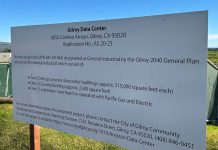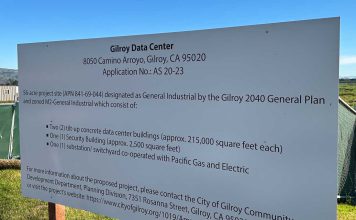
Behind Mike Cox’s medical diagnostic manufacturing plant in the small industrial park on Concord Circle in Morgan Hill, there is something magical – a scientifically designed and nurtured, 1.5-acre self-sustainable garden.
The 68-year-old microbiologist’s backyard, which runs parallel to the railroad tracks just south of Tennant Avenue, is perfectly landscaped with a variety of produce including tomatoes, corn, peppers, asparagus, lettuce and citrus. The crops grow in fertilizer extracted by Cox from grape pomace, a brittle combination of skins, pulp, seeds and stems left after the grapes are crushed in the winemaking process.
In the middle of Cox’s garden is an 18-by-100 strip of manicured grass, where in September a spacious wooden table will be set up for 100 special guests to enjoy a “farm-to-table dinner.” Cox, a Texas native who has lived and worked in Morgan Hill for more than a decade, wants to introduce his scientific, renewable energy model that turns organic waste such as grass clippings, fruit/vegetable matter and cellulose into hydrogen. The byproduct of that conversion – which only takes six hours – is a liquid compost.
“Most of the food will have traveled maybe 150 feet,” said Cox, who will host the Sept. 21 dinner along with his wife, Mary. The menu will include gazpacho, roasted butternut squash, salmon from Monterey Bay, grass-fed beef from a local butcher and a huge vegetable paella.
“Quite frankly, I do it because it’s fun, and it’s also good for the community,” added Cox, who will lead his staff in cooking most of the food in a pair of large, brick pizza ovens situated behind his office. “In the process of the dinner, they are going to learn this whole model of sustainable agriculture, and the fact that so much of the resources they’re currently throwing away could be turned into very valuable product.”
Tickets are $75 per person and will be available for purchase during the Leadership Morgan Hill tribute dinner July 27 at Guglielmo Winery, where Cox will also receive his Leadership Excellence Award. Among his other endeavors, Cox hosts, sponsors and cooks for fundraising events at his home for a variety of organizations, including the Morgan Hill Library, the Morgan Hill Community Foundation and the Independence Day Celebrations nonprofit committee.
“He’s a fantastically successful businessman who’s also very supportive of the community,” said Morgan Hill Mayor Steve Tate, whose wife has a designated garden box in Cox’s backyard wonderland. “He’s just a fantastic community builder. He gets people together around a common cause.”
The man who once sold his patented, oxygen-free “Cox Chamber” to NASA, which used the device to take moon rocks apart without exposing them to any gas, doesn’t seem to have an off button. Tell him something is impossible and he’ll try to prove otherwise.
Cox began his quest for renewable energy during the country’s first energy crisis in 1973, a time when Americans waited hours in line to buy gasoline. He studied different bacteria organisms, identified which ones produced hydrogen and then built a chamber to extract it.
“Knowing that these organisms made all these end products, I realized we could make renewable energy with lots of things that are available,” explained Cox.
He zeroed in on the potential of wineries – specifically for their grape pomace – as a potential key player in the process.
First, he extracts ethanol – which “has a value of its own,” says Cox – from the grape pomace. Then he begins to convert the waste into hydrogen by using a steel-encased chamber, another one of his inventions that looks like a contraption straight out of the cult movie classic “Back to the Future” series.
“So we get the ethanol off, adjust the pH – so we can ferment it – and make a whole bunch of hydrogen from it. Then, what’s left is a sterile, organic fertilizer that we use,” described the University of Houston alumnus who served in the Army during the Vietnam War.
Cox oversaw the Army’s microbiology lab at Fort Ord in Monterey County. From there, he spent two years as a medical microbiologist at Stanford Hospital before starting his Anaerobe Systems company in 1978. Anaerobe, which Cox relocated to Morgan Hill in 1997, is the only one of its kind and ships 15,000 plates of Anaerobic bacteria per day to hospitals, universities, veterinary hospitals, pharmaceuticals and laboratories around the world, which use the matter for research, to diagnose diseases and to develop and test new drugs.
Wearing his long, white lab coat and glasses, the white-bearded, charismatic gentleman – who has mentored about 150 college and high school interns who regularly advance into prominent universities and careers – is equal parts scientist and inventor.
But the Morgan Hill resident is no stranger to agriculture either, having grown up on a farm in his native Texas. So it was not outside of his domain to delve into the dirt, inviting each of his 22 employees at Anaerobe to grow herbs and vegetables of their choice in his garden.
“It’s been a really incredible thing to tie the employees closer together. They advise each other on what’s working, what’s not working. So, it’s kind of been fun,” said Cox, who, on this particular afternoon, harvested some tomatoes – one of 35 different strands in his garden – and a bit of Swiss chard that he planned to use later in a steamed sea bass dish for dinner with his wife.
Dinner always includes produce from his garden, but the big-hearted genius doesn’t like to keep everything to himself and his family, which includes son, Steve, 31, an engineer who works with him at Anaerobe, and daughter, Laurie, 30, a soon-to-be graduate of NYU Medical School with a Ph.D in microbiology.
Rather, Cox wants everyone to share in the fruits of his labor. He also welcomes other home gardeners and farmers to visit Anaerobe and mimic his model of sustainability.
Along with his farm-to-table dinner in September, Cox plans to host intimate “education-based dinners” – although dates have not yet been scheduled for them – to pass along his vast knowledge and so visitors can “understand the importance of microbiology in the crop cycle.”












